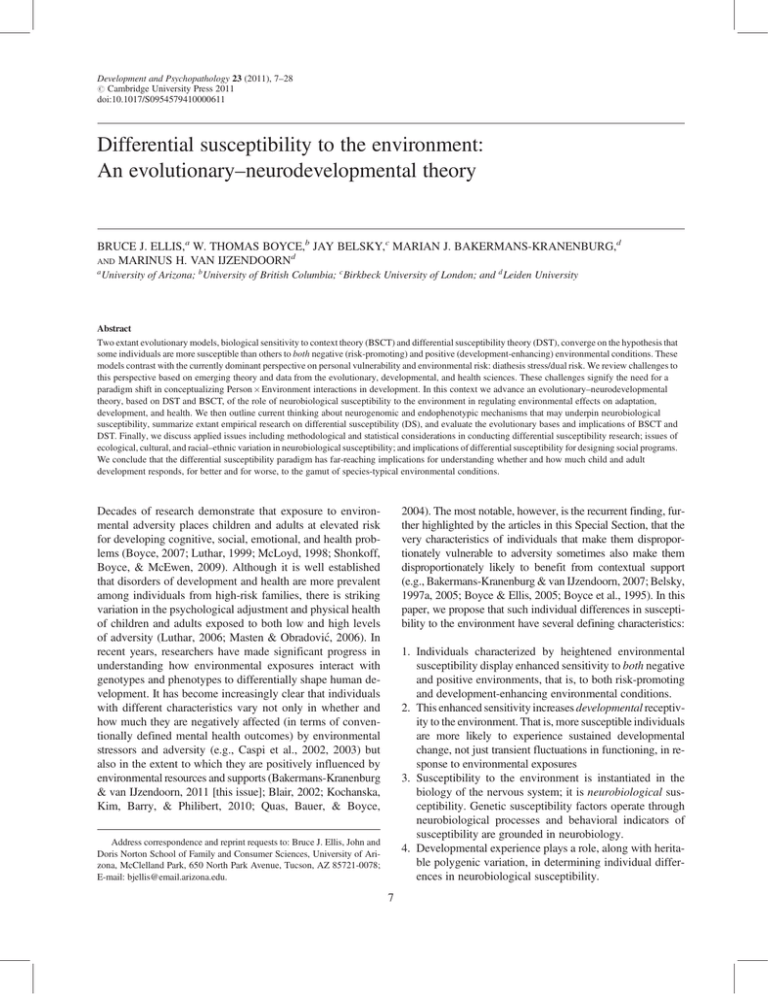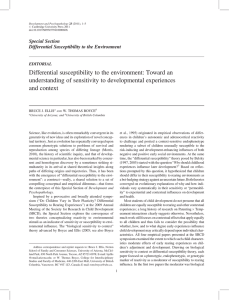Differential susceptibility to the environment: An evolutionary–neurodevelopmental theory BRUCE J. ELLIS,
advertisement

Development and Psychopathology 23 (2011), 7–28 # Cambridge University Press 2011 doi:10.1017/S0954579410000611 Differential susceptibility to the environment: An evolutionary–neurodevelopmental theory BRUCE J. ELLIS,a W. THOMAS BOYCE,b JAY BELSKY,c MARIAN J. BAKERMANS-KRANENBURG,d d AND MARINUS H. VAN IJZENDOORN a University of Arizona; b University of British Columbia; c Birkbeck University of London; and d Leiden University Abstract Two extant evolutionary models, biological sensitivity to context theory (BSCT) and differential susceptibility theory (DST), converge on the hypothesis that some individuals are more susceptible than others to both negative (risk-promoting) and positive (development-enhancing) environmental conditions. These models contrast with the currently dominant perspective on personal vulnerability and environmental risk: diathesis stress/dual risk. We review challenges to this perspective based on emerging theory and data from the evolutionary, developmental, and health sciences. These challenges signify the need for a paradigm shift in conceptualizing Person Environment interactions in development. In this context we advance an evolutionary–neurodevelopmental theory, based on DST and BSCT, of the role of neurobiological susceptibility to the environment in regulating environmental effects on adaptation, development, and health. We then outline current thinking about neurogenomic and endophenotypic mechanisms that may underpin neurobiological susceptibility, summarize extant empirical research on differential susceptibility (DS), and evaluate the evolutionary bases and implications of BSCT and DST. Finally, we discuss applied issues including methodological and statistical considerations in conducting differential susceptibility research; issues of ecological, cultural, and racial–ethnic variation in neurobiological susceptibility; and implications of differential susceptibility for designing social programs. We conclude that the differential susceptibility paradigm has far-reaching implications for understanding whether and how much child and adult development responds, for better and for worse, to the gamut of species-typical environmental conditions. Decades of research demonstrate that exposure to environmental adversity places children and adults at elevated risk for developing cognitive, social, emotional, and health problems (Boyce, 2007; Luthar, 1999; McLoyd, 1998; Shonkoff, Boyce, & McEwen, 2009). Although it is well established that disorders of development and health are more prevalent among individuals from high-risk families, there is striking variation in the psychological adjustment and physical health of children and adults exposed to both low and high levels of adversity (Luthar, 2006; Masten & Obradović, 2006). In recent years, researchers have made significant progress in understanding how environmental exposures interact with genotypes and phenotypes to differentially shape human development. It has become increasingly clear that individuals with different characteristics vary not only in whether and how much they are negatively affected (in terms of conventionally defined mental health outcomes) by environmental stressors and adversity (e.g., Caspi et al., 2002, 2003) but also in the extent to which they are positively influenced by environmental resources and supports (Bakermans-Kranenburg & van IJzendoorn, 2011 [this issue]; Blair, 2002; Kochanska, Kim, Barry, & Philibert, 2010; Quas, Bauer, & Boyce, 2004). The most notable, however, is the recurrent finding, further highlighted by the articles in this Special Section, that the very characteristics of individuals that make them disproportionately vulnerable to adversity sometimes also make them disproportionately likely to benefit from contextual support (e.g., Bakermans-Kranenburg & van IJzendoorn, 2007; Belsky, 1997a, 2005; Boyce & Ellis, 2005; Boyce et al., 1995). In this paper, we propose that such individual differences in susceptibility to the environment have several defining characteristics: 1. Individuals characterized by heightened environmental susceptibility display enhanced sensitivity to both negative and positive environments, that is, to both risk-promoting and development-enhancing environmental conditions. 2. This enhanced sensitivity increases developmental receptivity to the environment. That is, more susceptible individuals are more likely to experience sustained developmental change, not just transient fluctuations in functioning, in response to environmental exposures 3. Susceptibility to the environment is instantiated in the biology of the nervous system; it is neurobiological susceptibility. Genetic susceptibility factors operate through neurobiological processes and behavioral indicators of susceptibility are grounded in neurobiology. 4. Developmental experience plays a role, along with heritable polygenic variation, in determining individual differences in neurobiological susceptibility. Address correspondence and reprint requests to: Bruce J. Ellis, John and Doris Norton School of Family and Consumer Sciences, University of Arizona, McClelland Park, 650 North Park Avenue, Tucson, AZ 85721-0078; E-mail: bjellis@email.arizona.edu. 7





